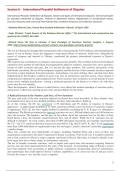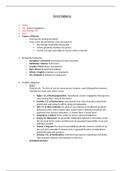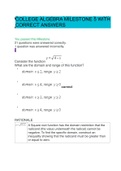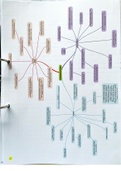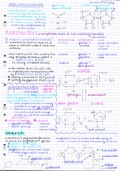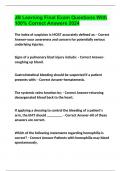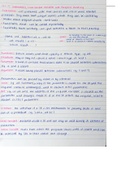Session 6 - International Peaceful Settlement of Disputes
International Peaceful Settlement of Disputes. Notion and types of international disputes. General principles
for peaceful settlement of disputes. Political or diplomatic means. Adjudication or jurisdictional means.
Coercive measures and control of international law: unilateral measures and collective sanctions.
· Rainbow Warrior Case, France-New Zealand Arbitration Tribunal. 30 April 1990
· Pugh, Michael. “Legal Aspects of the Rainbow Warrior Affair.” The International and comparative law
quarterly 36.3 (1987): 655–669.
· Richard Oscar, The War in Ukraine: A New Paradigm of Sanctions Practice, Lawfare, 1 August,
2022. https://www.lawfareblog.com/war-ukraine-new-paradigm-sanctions-practice
The war in Ukraine has disrupted the international order, reenergizing the NATO alliance and reimagining the
specter of war in Europe. It has also triggered a warp-speed rollout of sanctions, which have, alongside the
export of weapons and materiel to Ukraine, constituted the primary international response to Russia’s
aggression.
This response has constituted a sea change in sanctions practice globally. The world has witnessed a breakneck
expansion of the number of individuals and organizations added to countries’ sanctions lists, not to mention a
torrent of wider economic measures. But it is not just the sheer numbers: The seniority and profile of the
individuals sanctioned, the size of the companies targeted, and the ferocity of the economic measures imposed
have been a major departure from prior practice. And perhaps even more striking, these sanctions have been
implemented by the broadest coalition of actors ever seen in autonomous sanctions action, whose degree of
cooperation has deepened to unprecedented levels. These measures have resulted in a record amount of assets
frozen across multiple jurisdictions—raising a profound question for the future as to what to do with these
assets once the war subsides.
These developments, which I discuss in detail below, have altered the modern paradigm of sanctions policy
and practice, collectively opening up new risks and possibilities for the future.
A Radical Increase in the Number, and Pace, of New Sanctions
The pace and scale of the new sanctions imposed on Russia have been incredible. In three months’ time,
governments have more or less doubled portfolios that have taken decades to build up.
As of this writing, the EU has sanctioned 1,158 individuals and 98 entities in response to Russia’s
aggression—an approximate doubling of its entire sanctions portfolio across the dozens of sanctions regimes
it implements. The U.K. has also roughly doubled its portfolio (excluding the U.N. listings it is obligated to
implement): The British government has imposed sanctions on over 1,000 individuals and over 100 businesses
since the invasion. The numbers, and the pace of the rollout, dwarf the sanctions lists for the likes of Iran,
North Korea, Libya, the thematic counterterrorism lists, and all others. While the U.S. sanctions lists are
difficult to interpret—by some counts, more than 10,000 individuals and entities are currently sanctioned by
the U.S.—the U.S. action too has been at a pace not seen before. Like the EU and U.K., the U.S. has sanctioned
more than 1,000 individuals or organizations since the war began. Canada’s sanctions system has experienced
a similar change.
These lists contain the most high-profile of targets, including Vladimir Putin and a host of elites and
organizations connected to the state or important to Russia’s economy. Prior to the war, it would be relatively
rare to find a top-level official or major company sanctioned in Russia. But today, it is hard to identify a top-
level target who has not been subject to autonomous sanctions.
The use of broader economic sanctions, such as import and export bans and measures targeting financial
services, has also been unprecedented in the wake of the invasion. An astonishing range of Russia’s sectors
have been targeted, from accounting, to public relations, consultancy, broadcasting, dual-use technologies,
and technologies that could improve Russia’s defense capabilities, as of course has the oil and gas sector.
Overall, the scope is vast, and this is just a snapshot.
1
,Some similar restrictions can be found in other sanctions regimes. But as a totality against a single target,
action to this extent has not been seen before. And sanctioning countries have found new innovations, too:
Measures targeting Russia’s central bank have restricted Russia’s ability to access its foreign reserves and
control inflation in the country, exposing a hitherto unrealized vulnerability in the war chest that had been
built up in recent years. Measures targeting Russian companies have restricted their ability to raise new capital
from international sources. These measures point toward increasing sophistication of sanctions as meaningful
tools of economic pressure.
This flood of sanctions will inevitably attract a significant number of legal challenges in the coming years, the
outcomes of which will shape sanctions practice for years to come. Indeed, several high-profile individuals
have already announced challenges against sanctions imposed on them by the EU. But for the time being,
sanctioning countries have been emboldened to move well beyond previous convention in the number, speed,
and impact of the new measures.
New Autonomous Sanctions Players
A fundamental debate in contemporary sanctions practice concerns their appropriate moral and legal basis.
Countries tend to disagree on whether sanctions should be imposed independently (or “autonomously”) of the
U.N. That is, some actors view such autonomous sanctions as legitimate, and others challenge the lawfulness
and legitimacy of sanctions imposed outside the U.N. system. In recent years, autonomous sanctions have
grown more popular, particularly with the rise of the EU as a major autonomous sanctions actor. The
polarization of the Security Council’s permanent five (P5) members also hindered U.N. activity on major files
such as Syria and North Korea, given the P5 veto power. In May, for instance, Russia and China vetoed
tougher sanctions on North Korea after the latter’s latest ballistic missile tests.
Because the Ukraine crisis has constituted a breach of international security by a permanent member of the
Security Council, countries have been compelled to respond with autonomous sanctions, and such autonomous
action has gained credibility. U.N. action has been impossible, seeing as members of the Security Council can
veto the imposition of any new sanctions regimes at the U.N. This, for an important moment, dampened the
voices of those skeptical of autonomous sanctions, such as some of those who typically sign up to U.N.
resolutions criticizing unilateral coercive measures. The existing autonomous sanctions players (the U.S.,
U.K., and EU) would not have been deterred by such voices. But this has caused others to meaningfully
reconsider whether there is a role for autonomous sanctions and has created the political space for these actors
to impose such sanctions for the first time.
Prior to the Ukraine war, the world of autonomous sanctions was in reality constituted by a very small number
of active participants who generally collaborated on an ad hoc basis. The field was dominated by the U.S.,
with the other main participants being the EU, the U.K., Canada, and Australia. While collaboration among
this group was developing, outreach to expand this field of players was piecemeal, despite growing
parliamentary and civil society calls for a broader coalition, particularly for human rights and anti-corruption
(so-called Magnitsky) sanctions.
The war in Ukraine has led to a step change in the breadth and depth of cooperation on autonomous sanctions.
There have been striking examples of countries that have historically balked at the imposition of sanctions—
both because of a principled opposition to restrictive measures imposed outside multilateral fora, and because
of broader historical positions on neutrality or non-intervention—imposing sanctions for the first time.
For example, at the time of this publication:
Japan, which has historically expressed a highly cautious position on autonomous sanctions and a
broader reserve about controversial foreign policy interventions, has imposed individual and entity
sanctions against hundreds of Russian and Belarusian targets.
New Zealand, the only member of the Five Eyes intelligence sharing community not to have domestic
laws enabling the imposition of autonomous sanctions—due to a position anchored in a concern around
the legitimacy of autonomous sanctions and how participation could be viewed among their developing
country partners and allies—has now imposed more than 700 individual or entity sanctions under its
new Russia Sanctions Act, as well as banking and export restrictions.
Switzerland, despite its long-standing position of neutrality and the importance of this position to
cultivating a stable environment where international elites can safely store their money, decided to
implement the EU’s sanctions on Russian and Belarussian targets.
Monaco, Liechtenstein, and Iceland announced they will mirror EU sanctions.
2
, South Korea announced it would implement both U.S. and EU sanctions.
Singapore—which has not imposed independent sanctions since 1978, when it did so in response to
Vietnam’s invasion of Cambodia—unveiled unilateral sanctions against Russian banks and entities, as
well as fundraising activities that benefit the Russian government, in March.
Taiwan has announced it will “join international economic sanctions against Russia” and has banned
the exports of high-tech products to Russia and Belarus, including a ban on semiconductor chips and
materials.
Importantly, many of these new entrants are focal points of global capital—meaning that their participation
expands the effect of financial sanctions measures considerably.
Deeper Cooperation
Within the “core” participants in the network of autonomous sanctions actors, the degree and sophistication
of practical cooperation has increased markedly. Countries are now routinely coordinating more deeply than
ever, resulting in regularly coordinated announcements. Conflict can bring together coalitions and can be a
crucible for learning; we have seen these effects manifested in the collective actions of the autonomous
sanctions powers. In the absence of a formal sanctions coordinating body, the G-7 has become a forum for
cooperation, linking together the U.S., the U.K., Canada, the EU, and Japan, but also linking with other
countries and providing a credible grouping with which new sanctions entrants can align themselves (as
opposed to, for example, copying and pasting U.S. sanctions).
The countries that have imposed sanctions for the first time, in crossing this political Rubicon, are more likely
to have the political will to impose them in the future, as other crises emerge. Lawmakers and civil society
groups will be emboldened by the precedent when they call for sanctions to address other issues. These
countries have also developed important legal and technical capabilities that will outlast the war in Ukraine.
To take autonomous sanctions action beyond the basic imposition of travel bans requires more than simply
assenting to implement U.N. measures. It usually requires individualized legislation (as seen in the cases of
Japan and New Zealand), dedicated sanctions teams, and resources allocated to enforcing the sanctions that
are imposed. All of these enhanced capacities can be deployed to other crises or issues in the future.
Unprecedented Amounts of Frozen Assets
Russian oligarchs live flamboyant lives. They own the most desirable properties, and they run enormous
current account balances. Some have penchants for yachts moored in exotic locations. It would have been
politically unacceptable to impose sanctions against these individuals without the follow-up to ensure that
their very visible assets were effectively frozen. Even countries without autonomous sanctions regimes have
felt the political pressure to ensure that their jurisdictions are not used as safe havens from the measures
imposed by autonomous sanctions powers, and have accordingly made announcements that they will enforce
those sanctions. Consequently, we have seen the spectacle of government forces commandeering oligarchs’
yachts, seizing Lake Como mansions, and announcing multiple billions of dollars of assets frozen. Indeed, the
Russian Elites, Proxies, and Oligarchs Task Force—a task force of top finance and justice officials from the
U.S., Australia, France, Canada, Germany, Japan, Italy, the U.K., and the European Commission—announced
in June that they had blocked $30 billion in assets of Russian officials and frozen $300 billion owned by the
Russian central bank, an eye-wateringly large number.
It is impossible to assess this claim independently, but it would nonetheless be difficult to dispute that the
amounts collectively sanctioned since Russia’s invasion are an order of magnitude larger than under any other
sanctions regime in recent years. (The U.K.’s Office of Financial Sanctions Implementation reported that, as
of September 2020, a total of $14.9 billion worth of assets were frozen across the U.K.’s sanctions regimes.
The British government reports that almost $316.7 billion worth of Russian bank assets have now been
frozen—marking an approximate 20-fold increase.)
The challenge once the war subsides is what to do with these frozen assets. Some officials have called to seize
these assets and use them to compensate the Ukrainian people for the damage caused by the invasion. Indeed,
the Canadian government has already passed legislation and the U.S. is seeking additional legal authority to
make it easier for them to do so. This is not going to be straightforward, for a number of reasons. But it is
clear that the neat distinction between the practice of sanctions (freezing assets on the basis of “civil” standards
of evidence, using government administrative measures, with a view to behavior change) and asset seizure
(seizing and then repatriating assets on the basis of criminal standards of evidence, through the court system,
3
, with a view to justice, accountability, and recompensing the victim) is going to come under serious challenge
in the coming months and years.
A Shifting Sanctions Paradigm?
No firm conclusions can be drawn while we are still in media res—that is, much remains to be seen at this
moment. However, the sanctions response to Russia’s war in Ukraine appears to be shifting global sanctions
practice in new directions.
The world is watching the rise of a broader, more diverse, coalition of countries deploying autonomous
sanctions. These countries are also more deeply networked and cooperating in more sophisticated ways,
seeking to defend national and collective interests and shared norms via the coordinated imposition of
sanctions. There will likely be stronger calls for more formal coordination—perhaps through the G-7, or even
a bespoke international sanctions body—which will in turn create tensions as others fear the displacement of
the United Nations. Moreover, one can expect stronger protest from those who are entrenched in positions
opposed to autonomous sanctions. Greater coordination on sanctions between centers of global capital will
strengthen financial pressures imposed on bad actors. And given the enormous pools of assets now frozen
under autonomous sanctions regimes, it is possible that a greater degree of connection between global
sanctions and international asset recovery will be forged—for instance, through the creation of mechanisms
to compensate victims using seized capital.
These developments would mark a significant shift, not just in sanctions practice, but in the manner in which
states and multinational organizations seek to instill and defend international norms.
The Rainbow Warrior case
It is a notable incident in international law involving the bombing of the Greenpeace ship Rainbow Warrior
by French agents in New Zealand in 1985. The case had significant legal and diplomatic ramifications,
particularly concerning state responsibility and the peaceful resolution of disputes.
Background and Events
1. Greenpeace and the Rainbow Warrior: The Rainbow Warrior was a ship owned by the environmental
organization Greenpeace. It was used to protest against nuclear testing in the Pacific, including
French nuclear tests at Mururoa Atoll.
2. Bombing of the Rainbow Warrior: On July 10, 1985, French intelligence agents (DGSE) planted bombs
on the Rainbow Warrior while it was docked in Auckland, New Zealand. The explosions sank the ship
and resulted in the death of a Greenpeace photographer, Fernando Pereira.
3. French Agents Arrested: Two French agents, Dominique Prieur and Alain Mafart, were arrested by
New Zealand authorities. They were charged and eventually pleaded guilty to manslaughter,
receiving ten-year prison sentences.
4. Diplomatic Fallout: The bombing caused an international scandal, straining relations between New
Zealand and France. France initially denied involvement but later admitted responsibility.
Legal and Diplomatic Outcomes
1. United Nations Involvement: The dispute was brought before the United Nations. Secretary-General
Javier Pérez de Cuéllar mediated between France and New Zealand to resolve the conflict.
4

